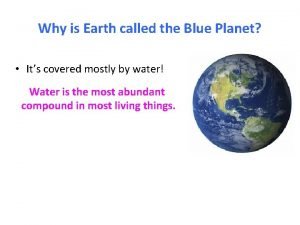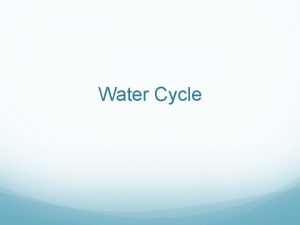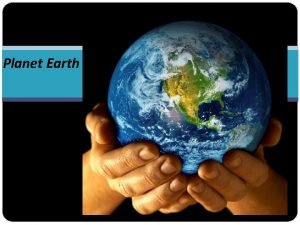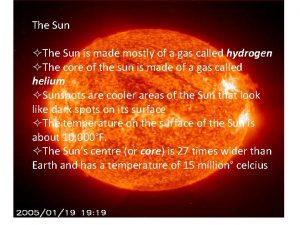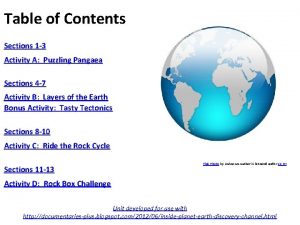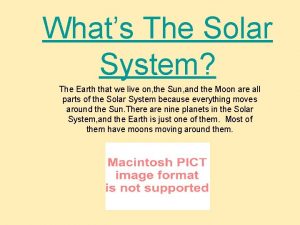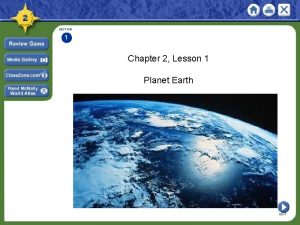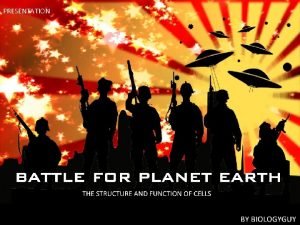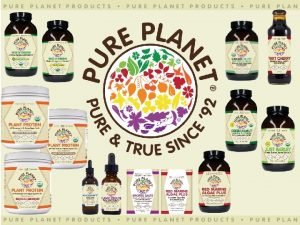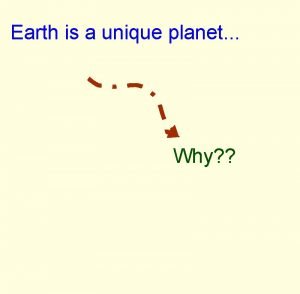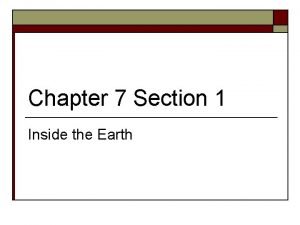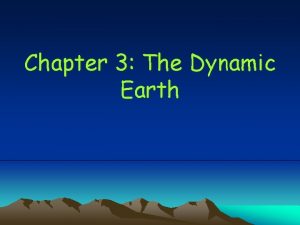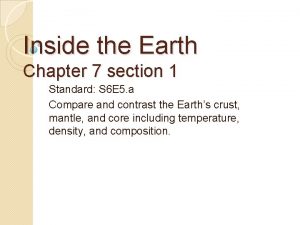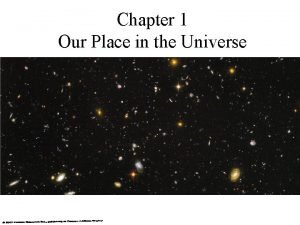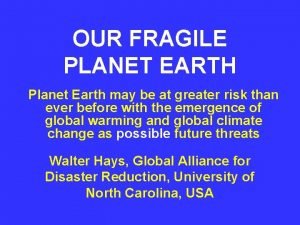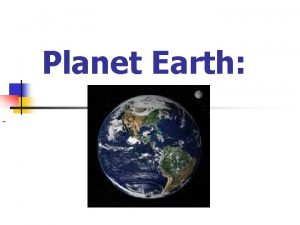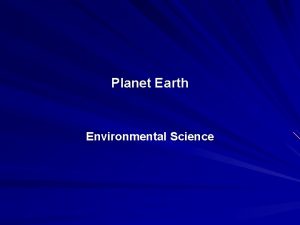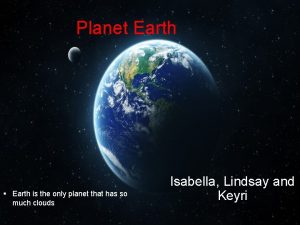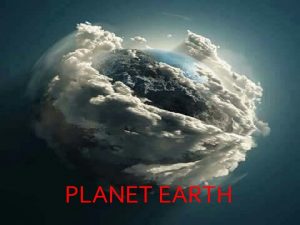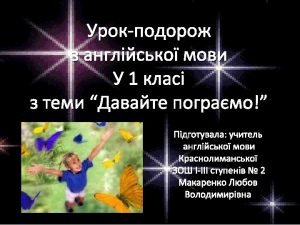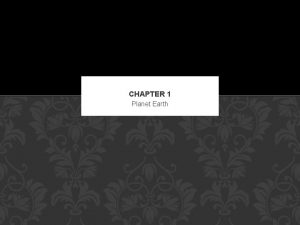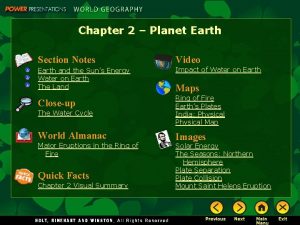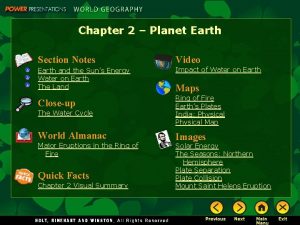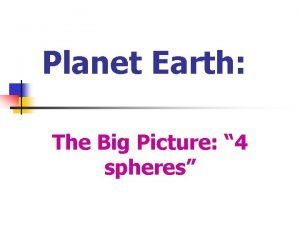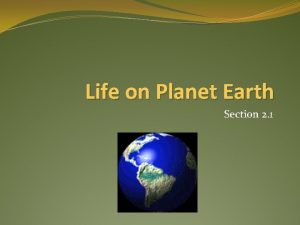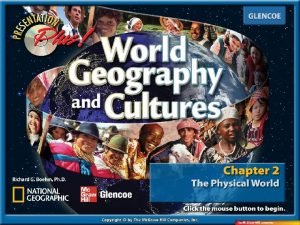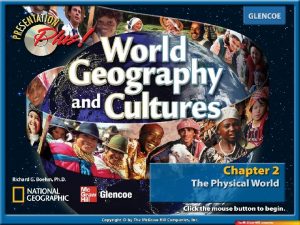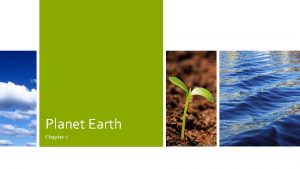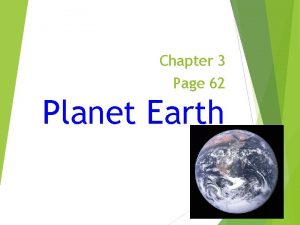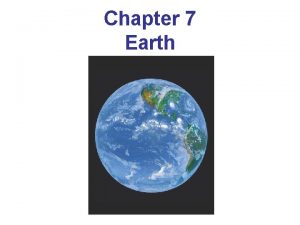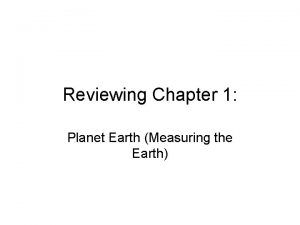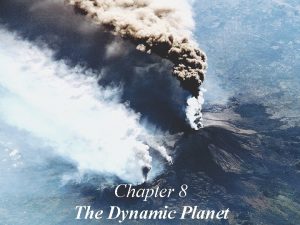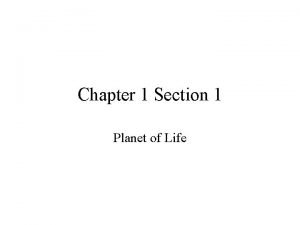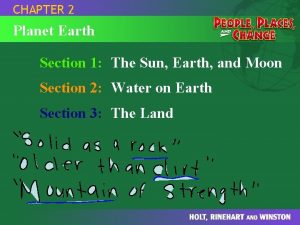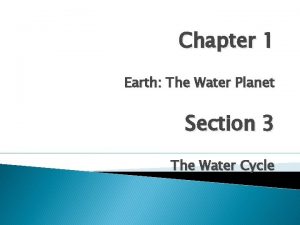Chapter 2 The Earth Section I Planet Earth





















































- Slides: 53

Chapter 2 The Earth

Section I. Planet Earth What do you know about the Solar System?

A. Our Solar System The sun is at the center of our Solar System Sun creates a strong pull of gravity Keeps objects such as Earth revolving around the Sun

Our Solar System Revolution – in astronomy, the Earth’s yearly trip around the sun 365 ¼ days Why is the ( ¼ ) important to know? ? Rotation – the Earths daily trip turning on its axis How long is a day?

In history…. People believed that the solar system revolved around Earth Geocentrism Connected to religion But it was Galileo (16 th century) that actually fought for the now accepted theory that we were the ones moving Heliocentrism

What’s the idea behind theories? Why would people think we were geocentric? ? Which theory would you side with if you had to choose? What would happen without the sun?


The “Classical” Planets: Neighbors in Space Before it was believed we had nine planets now we just classify eight Inner Planets (Terrestrial) Mercury Venus Earth Mars (only one with sustainable life)

The “Classical” Planets: Neighbors in Space Outer Planets (Gas Giants) Jupiter Saturn Uranus Neptune All have moons except Mars & Venus There also asteroids, comets and meteoroids

Pluto……. . planet? ? Discovery Channel, August 24 th, 2006 [Much-maligned Pluto doesn't make the grade under the new rules for a planet: "a celestial body that is in orbit around the sun, has sufficient mass for its self-gravity to overcome rigid body forces so that it assumes a. . . nearly round shape, and has cleared the neighborhood around its orbit. “] [Pluto is automatically disqualified because its oblong orbit overlaps with Neptune's. ]

B. Getting to know the Earth The earth is divided into categories Hydrosphere – part of Earth made up of oceans, lakes, rivers, and other bodies of water Lithosphere – part of Earth made up of continents and islands Atmosphere – a layer of gases that surrounds the Earth Biosphere – the part of the Earth that supports life

Hydrosphere = WATER Earth is 70% water

Lithosphere = Land Earth is 30% land

Atmosphere = Air Above earth’s surface you have a layer of gases 78% nitrogen, 21% oxygen and the rest argon and other gases Our natural vegetation is essential to the recyclement of our oxygen

Biosphere = life The part of earth that supports life Life outside of the biosphere only exist with mechanical life support system Space shuttle

Air + Land + Water = Biosphere! Bio=life! Hence, Biology….

C. Landforms Natural features of the earth’s surface that vary in shape and elevation 4 major landforms Mountains Hills Plateaus All contain rivers, lakes and streams Plains Also have valleys, canyons, and basins

Underground Landforms underwater are as diverse as those found on dry land Range from flat plains to mountain ranges, cliffs, valleys and deep trenches

Earth’s most visible landforms From space the most visible landforms are the 7 continents Australia Antarctica Europe Asia North America South America Africa **** Locate continents on your map ****

Continental Shelf Part of a continent that extends underwater


Long narrow underground canyon (Pacific Ocean)

Section II. Forces of Change How does earth change? What processes are responsible for such changes?

Forces of Change On the surface Wind, water, etc Originate from the interior Volcanic eruptions, earthquakes, etc

Earth’s Structure The earth is composed of three layers

Core Inner core is made up of iron and nickel under enormous pressure Outer layer is liquid made up of melted iron and nickel

Mantle Thick layer of hot dense rock Mixture of elements that continually rises, cools, sinks, warms up and rises again Responsible of 80% of heat generated from earth’s interior

Crust Broken up into more than a dozen great slabs of rock called plates that rest (float) on a partially melted layer in the upper mantle Carry the earth’s oceans and continents

Continental Drift Theory Pangaea Theory that all the continents were once joined and slowly started to drift apart

Plate theory “Continental Drift” Pangaea – a gigantic supercontinent that eventually broke apart (drifted) into smaller continents due to plate movement

Crust=Plates

Plate Tectonics Plates are continually moving At times they may crash, pull apart, grind or slide past each other Constantly changing the face of the planet They push up mountains, create volcanoes, and produce earthquakes Theory: heat rising from the core create slowmoving currents within the mantle which then shift the plates around

Crust=Plates

Internal forces of change 1. 2. 3. 4. 5. 6. 7. 8. Colliding Subduction Accretion Spreading Folds Faults Earthquakes Volcanic Eruptions

1. Colliding Giant continental plate collide Creates mountains Himalayas

2. Subduction A heavier sea plate dives beneath the lighter continental plate Plunging into the earth’s interior, the sea plate becomes molten material Then as magma it bursts through the crust to form volcanic mountains Andes

3. Accretion Pieces of earth’s crust come together slowly as the sea plate slides under the continental plate Creates underwater mountains with steep sides and sharp peaks Creates new land often island chain at the boundary

4. Spreading Sea plates pull apart Deep cracks (rift) allow magma from within the earth to well up between the plates Magma hardens to build undersea volcanic mountains or ridges Spreading keeps Europe and N. Ame apart

5. Folds (bends) Moving plates squeeze the earth’s surface until it buckles or creates folds in layers of rock

6. Faults Plates grind or slide past each other creating cracks in earth’s crust When land can no longer be folded the earth’s crust cracks and breaks into huge blocks Small tremors occur San Andres Fault in CA

7. Earthquakes Sudden, violent movements of plates along a fault line Dramatically change the surface of the land the floor of the ocean Happen when different plates meet each other. Tension builds up as the plates stick. The strain becomes so intense that the rocks suddenly snap and shift. This releases stored up energy along the fault. Eventually the ground trembles as sends shock waves which are felt

Ring of Fire Earthquake and volcano zone surrounding the Pacific Ocean Boundary where the plates that cradle the Pacific meet the plates that hold the continents surrounding the ocean

8. Volcanoes are mountains formed by lava or magma that breaks through the earth’s crust Often rise along plate boundaries where one plate plunges beneath another In such a process the rocky plate melts as it dives downward into the hot mantle. Pressure builds, a funnel is created and hot magma rushes to the surface. The lava will eventually create a volcano

Volcanoes As a moving plate passes over these hot spots, molten rock flowing out of the earth’s surface may create volcanic island chains Hawaiian Islands Molten rock may also heat underground water causing hot springs or geysers Yellowstone

External Forces of Change Wind and water change the earth’s surface (two processes) Weathering – process that breaks down rocks on the earth’s surface into smaller pieces Erosion – wearing away of the earth’s surface by wind, glaciers, and moving water 1. Weathering 2. Wind Erosion 3. Glacial Erosion 4. Water Erosion

Weathering Either physical weathering or chemical weathering Physical – when large masses of rock are physically broken down into smaller pieces Water seeps into the cracks in a rock and freezes, then expands and causes the rock to split Chemical – changes in the chemical makeup of rocks (transforming their minerals or combining them) Water mixed with carbon dioxide from the air easily dissolves certain rocks such as limestone

Wind Erosion Movement of dust, sand, and soil from one place to another Can be devastating or beneficial Dust Bowl China Yellow River basin is thickly covered with loess (fertile yellow-gray soil deposited by wind)

Glacial Erosion Glaciers – large bodies of ice that slowly move across the earth’s surface Glacial movements change the landscape by destroying forests, carving our valleys, etc However, when glaciers melt and recede they leave behind large pules of rocks and debris (moraines) Moraines can form long ridges of land or create glacial lakes

Water Erosion Most significant cause of erosion Fast moving water – rain, rivers, streams, and oceans – cuts into the land wearing away the soil and rock The resulting sediment (small particles of soil, sand gravel) act like sandpaper and cut away at land Grand Canyon

Section 3 – Earth’s water Hydrosphere!! Almost all of the hydrosphere is salt water found in the oceans, seas and seawater lakes The remainder is freshwater found in lakes, rivers, and springs

Water Cycle Regular Evaporation – sun, changing liquid into vapor or gas Condensation – excess water vapor changes into liquid form 1. 2. 1. 3. movement of water through Forms clouds Precipitation – rain, snow, or sleet that sinks into the grounds and soon is evaporated again

Bodies of Salt Water (97%) Oceans 1. 2. 3. 4. 5. Pacific Atlantic Artic Southern Indian Seas, Gulfs, and Bays Desalination – conversion saltwater into freshwater

Freshwater (3%) Lakes, Streams, and Rivers Groundwater – freshwater that lies beneath the earth’s surface Comes from rain and melted snow that filter through the soil and from water that seeps into the ground from lakes and rivers Can use wells to tap into freshwater Aquifer – underground porous rock layer saturated with water in the form of streams
 Why is the earth called the blue planet
Why is the earth called the blue planet What is the earth called a blue planet
What is the earth called a blue planet We live in planet earth
We live in planet earth What is the core of the sun made of
What is the core of the sun made of Why is mantle material compared to the consistency of fudge
Why is mantle material compared to the consistency of fudge Whats the biggest planet in the solar system
Whats the biggest planet in the solar system Lesson 1 planet earth
Lesson 1 planet earth What is this
What is this Ns grade 7 term 4
Ns grade 7 term 4 Pure planet sports salts
Pure planet sports salts Why is the earth called a unique planet
Why is the earth called a unique planet Chapter 7 section 1 inside the earth answer key
Chapter 7 section 1 inside the earth answer key Three compositional layers of the earth
Three compositional layers of the earth Chapter 3 the dynamic earth section 1 the geosphere
Chapter 3 the dynamic earth section 1 the geosphere Composition of the earth's crust
Composition of the earth's crust Section quick check chapter 10 section 1 meiosis answer key
Section quick check chapter 10 section 1 meiosis answer key Sit on the planet chapter 1
Sit on the planet chapter 1 Hình ảnh bộ gõ cơ thể búng tay
Hình ảnh bộ gõ cơ thể búng tay Slidetodoc
Slidetodoc Bổ thể
Bổ thể Tỉ lệ cơ thể trẻ em
Tỉ lệ cơ thể trẻ em Gấu đi như thế nào
Gấu đi như thế nào Thang điểm glasgow
Thang điểm glasgow Bài hát chúa yêu trần thế alleluia
Bài hát chúa yêu trần thế alleluia Môn thể thao bắt đầu bằng chữ f
Môn thể thao bắt đầu bằng chữ f Thế nào là hệ số cao nhất
Thế nào là hệ số cao nhất Các châu lục và đại dương trên thế giới
Các châu lục và đại dương trên thế giới Công thức tính thế năng
Công thức tính thế năng Trời xanh đây là của chúng ta thể thơ
Trời xanh đây là của chúng ta thể thơ Mật thư anh em như thể tay chân
Mật thư anh em như thể tay chân Phép trừ bù
Phép trừ bù Phản ứng thế ankan
Phản ứng thế ankan Các châu lục và đại dương trên thế giới
Các châu lục và đại dương trên thế giới Thể thơ truyền thống
Thể thơ truyền thống Quá trình desamine hóa có thể tạo ra
Quá trình desamine hóa có thể tạo ra Một số thể thơ truyền thống
Một số thể thơ truyền thống Bàn tay mà dây bẩn
Bàn tay mà dây bẩn Vẽ hình chiếu vuông góc của vật thể sau
Vẽ hình chiếu vuông góc của vật thể sau Biện pháp chống mỏi cơ
Biện pháp chống mỏi cơ đặc điểm cơ thể của người tối cổ
đặc điểm cơ thể của người tối cổ Ví dụ về giọng cùng tên
Ví dụ về giọng cùng tên Vẽ hình chiếu đứng bằng cạnh của vật thể
Vẽ hình chiếu đứng bằng cạnh của vật thể Tia chieu sa te
Tia chieu sa te Thẻ vin
Thẻ vin đại từ thay thế
đại từ thay thế điện thế nghỉ
điện thế nghỉ Tư thế ngồi viết
Tư thế ngồi viết Diễn thế sinh thái là
Diễn thế sinh thái là Các loại đột biến cấu trúc nhiễm sắc thể
Các loại đột biến cấu trúc nhiễm sắc thể Số nguyên tố là gì
Số nguyên tố là gì Tư thế ngồi viết
Tư thế ngồi viết Lời thề hippocrates
Lời thề hippocrates Thiếu nhi thế giới liên hoan
Thiếu nhi thế giới liên hoan ưu thế lai là gì
ưu thế lai là gì
